*NURSING > QUESTIONS & ANSWERS > RN Med-Surg Practice Test Cardio P2 Questions and Answers with Explanations (STUDY MODE) Questions a (All)
RN Med-Surg Practice Test Cardio P2 Questions and Answers with Explanations (STUDY MODE) Questions and Answers (latest Update), 100% Correct, Download to Score A
Document Content and Description Below
Test Bank – Coronary Artery Disease and Acute Coronary Syndrome 1. When developing a teaching plan for a 61-year-old man with the following risk factors for coronary artery disease (CAD), the nurs... e should focus on the a. family history of coronary artery disease. b. increased risk associated with the patient’s gender. c. increased risk of cardiovascular disease as people age. d. elevation of the patient’s low-density lipoprotein (LDL) level. i. Because family history, gender, and age are nonmodifiable risk factors, the nurse should focus on the patient’s LDL level. Decreases in LDL will help reduce the patient’s risk for developing CAD. 2. Which nursing intervention will be most effective when assisting the patient with coronary artery disease (CAD) to make appropriate dietary changes? a. Give the patient a list of low-sodium, low-cholesterol foods that should be included in the diet. b. Emphasize the increased risk for heart problems unless the patient makes the dietary changes. c. Help the patient modify favorite high-fat recipes by using monosaturated oils when possible. i. Lifestyle changes are more likely to be successful when consideration is given to the patient’s values and preferences. The highest percentage of calories from fat should come from monosaturated fats. Although low-sodium and low-cholesterol foods are appropriate, providing the patient with a list alone is not likely to be successful in making dietary changes. Completely removing saturated fat from the diet is not a realistic expectation. Up to 7% of calories in the therapeutic lifestyle changes (TLC) diet can come from saturated fat. Telling the patient about the increased risk without assisting further with strategies for dietary change is unlikely to be successful. d. Inform the patient that a diet containing no saturated fat and minimal salt will be necessary. 3. Which assessment data collected by the nurse who is admitting a patient with chest pain suggest that the pain is caused by an acute myocardial infarction (AMI)? a. The pain increases with deep breathing. b. The pain has lasted longer than 30 minutes. i. Chest pain that lasts for 20 minutes or more is characteristic of AMI. Changes in pain that occur with raising the arms or with deep breathing are more typical of musculoskeletal pain or pericarditis. Stable angina is usually relieved when the patient takes nitroglycerin. c. The pain is relieved after the patient takes nitroglycerin. d. The pain is reproducible when the patient raises the arms. 4. Which information given by a patient admitted with chronic stable angina will help the nurse confirm this diagnosis? a. The patient states that the pain “wakes me up at night.” b. The patient rates the pain at a level 3 to 5 (0 to 10 scale). c. The patient states that the pain has increased in frequency over the last week. d. The patient states that the pain “goes away” with one sublingual nitroglycerin tablet. i. Chronic stable angina is typically relieved by rest or nitroglycerin administration. The level of pain is not a consistent indicator of the type of angina. Pain occurring at rest or with increased frequency is typical of unstable angina. 5. After the nurse has finished teaching a patient about the use of sublingual nitroglycerin (Nitrostat), which patient statement indicates that the teaching has been effective? a. “I can expect some nausea as a side effect of nitroglycerin.” b. “I should only take the nitroglycerin if I start to have chest pain.” c. “I will call an ambulance if I still have pain after taking 3 nitroglycerin 5 minutes apart.” i. The emergency medical services (EMS) system should be activated when chest pain or other symptoms are not completely relieved after 3 sublingual nitroglycerin tablets taken 5 minutes apart. Nitroglycerin can be taken to prevent chest pain or other symptoms from developing (e.g., before intercourse). Gastric upset (e.g., nausea) is not an expected side effect of nitroglycerin. Nitroglycerin does not impact the underlying pathophysiology of coronary artery atherosclerosis. d. “Nitroglycerin helps prevent a clot from forming and blocking blood flow to my heart.” 6. Which statement made by a patient with coronary artery disease after the nurse has completed teaching about therapeutic lifestyle changes (TLC) diet indicates that further teaching is needed? a. “I will switch from whole milk to 1% milk.” b. “I like salmon and I will plan to eat it more often.” c. “I can have a glass of wine with dinner if I want one.” d. “I will miss being able to eat peanut butter sandwiches.” i. Although only 30% of the daily calories should come from fats, most of the fat in the TLC diet should come from monosaturated fats such as are found in nuts, olive oil, and canola oil. The patient can include peanut butter sandwiches as part of the TLC diet. The other patient comments indicate a good understanding of the TLC diet. 7. After the nurse teaches the patient about the use of carvedilol (Coreg) in preventing anginal episodes, which statement by a patient indicates that the teaching has been effective? a. “Carvedilol will help my heart muscle work harder.” b. “It is important not to suddenly stop taking the carvedilol.” i. Patients who have been taking β-adrenergic blockers can develop intense and frequent angina if the medication is suddenly discontinued. Carvedilol (Coreg) decreases myocardial contractility. Shortness of breath that occurs when taking β-adrenergic blockers for angina may be due to bronchospasm and should be reported to the health care provider. Carvedilol works by decreasing myocardial oxygen demand, not by increasing blood flow to the coronary arteries. c. “I can expect to feel short of breath when taking carvedilol.” d. “Carvedilol will increase the blood flow to my heart muscle.” 8. A patient who has had chest pain for several hours is admitted with a diagnosis of rule out acute myocardial infarction (AMI). Which laboratory test should the nurse monitor to help determine whether the patient has had an AMI? a. Myoglobin b. Homocysteine c. C-reactive protein d. Cardiac-specific troponin i. Troponin levels increase about 4 to 6 hours after the onset of myocardial infarction (MI) and are highly specific indicators for MI. Myoglobin is released within 2 hours of MI, but it lacks specificity and its use is limited. The other laboratory data are useful in determining the patient’s risk for developing coronary artery disease (CAD) but are not helpful in determining whether an acute MI is in progress. 9. Diltiazem (Cardizem) is ordered for a patient with newly diagnosed Prinzmetal’s (variant) angina. When teaching the patient, the nurse will include the information that diltiazem will a. Reduce heart palpitations b. Decrease spasm of the coronary arteries i. Prinzmetal’s angina is caused by coronary artery spasm. Calcium channel blockers (e.g., diltiazem, amlodipine [Norvasc]) are a first-line therapy for this type of angina. Lipid-lowering drugs help reduce atherosclerosis (i.e., plaque formation), and β-adrenergic blockers decrease sympathetic stimulation of the heart (i.e., palpitations). Medications or activities that increase myocardial contractility will increase the incidence of angina by increasing oxygen demand. c. Increase the force of the heart contractions d. Help prevent plaque from forming in the coronary arteries 10. The nurse will suspect that the patient with stable angina is experiencing a side effect of the prescribed metoprolol (Lopressor) if the a. patient is restless and agitated. b. blood pressure is 90/54 mm Hg. i. Patients taking β-adrenergic blockers should be monitored for hypotension and bradycardia. Because this class of medication inhibits the sympathetic nervous system, restlessness, agitation, hypertension, and anxiety will not be side effects. c. patient complains about feeling anxious. d. cardiac monitor shows a heart rate of 61 beats/minute. 11. Nadolol (Corgard) is prescribed for a patient with chronic stable angina and left ventricular dysfunction. To determine whether the drug is effective, the nurse will monitor for a. decreased blood pressure and heart rate. b. fewer complaints of having cold hands and feet. c. improvement in the strength of the distal pulses. d. the ability to do daily activities without chest pain. i. Because the medication is ordered to improve the patient’s angina, effectiveness is indicated if the patient is able to accomplish daily activities without chest pain. Blood pressure and heart rate may decrease, but these data do not indicate that the goal of decreased angina has been met. The noncardioselective B-adrenergic blockers can cause peripheral vasoconstriction, so the nurse would not expect an improvement in distal pulse quality or skin temperature. 12. Heparin is ordered for a patient with a non–ST-segment-elevation myocardial infarction (NSTEMI). What is the purpose of the heparin? a. Heparin enhances platelet aggregation. b. Heparin decreases coronary artery plaque size. c. Heparin prevents the development of new clots in the coronary arteries. i. Heparin helps prevent the conversion of fibrinogen to fibrin and decreases coronary artery thrombosis. It does not change coronary artery plaque, dissolve already formed clots, or enhance platelet aggregation. d. Heparin dissolves clots that are blocking blood flow in the coronary arteries. 13. When titrating IV nitroglycerin (Tridil) for a patient with a myocardial infarction (MI), which action will the nurse take to evaluate the effectiveness of the medication? a. Monitor heart rate. b. Ask about chest pain. i. The goal of IV nitroglycerin administration in MI is relief of chest pain by improving the balance between myocardial oxygen supply and demand. The nurse also will monitor heart rate and blood pressure (BP) and observe for dysrhythmias, but these parameters will not indicate whether the medication is effective. c. Check blood pressure. d. Observe for dysrhythmias. 14. A patient with ST-segment elevation in three contiguous electrocardiographic (ECG) leads is admitted to the emergency department (ED) and diagnosed as having an ST-segment-elevation myocardial infarction (STEMI). Which question should the nurse ask to determine whether the patient is a candidate for thrombolytic therapy? a. “Do you have any allergies?” b. “Do you take aspirin on a daily basis?” c. “What time did your chest pain begin?” i. Thrombolytic therapy should be started within 6 hours of the onset of the myocardial infarction (MI), so the time at which the chest pain started is a major determinant of the appropriateness of this treatment. The other information will also be needed, but it will not be a factor in the decision about thrombolytic therapy. d. “Can you rate your chest pain using a 0 to 10 scale?” 15. Following an acute myocardial infarction (AMI), a patient ambulates in the hospital hallway. When the nurse is evaluating the patient’s response to the activity, which assessment data would indicate that the exercise level should be decreased? a. Blood pressure (BP) changes from 118/60 to 126/68 mm Hg. b. Oxygen saturation drops from 99% to 95%. c. Heart rate increases from 66 to 92 beats/minute. i. A change in heart rate of more than 20 beats over the resting heart rate indicates that the patient should stop and rest. The increases in BP and respiratory rate, and the slight decrease in oxygen saturation, are normal responses to exercise. d. Respiratory rate goes from 14 to 20 breaths/minute. 16. During the administration of the thrombolytic agent to a patient with an acute myocardial infarction (AMI), the nurse should stop the drug infusion if the patient experiences a. bleeding from the gums. b. increase in blood pressure. c. a decrease in level of consciousness. [Show More]
Last updated: 1 year ago
Preview 1 out of 29 pages
Instant download
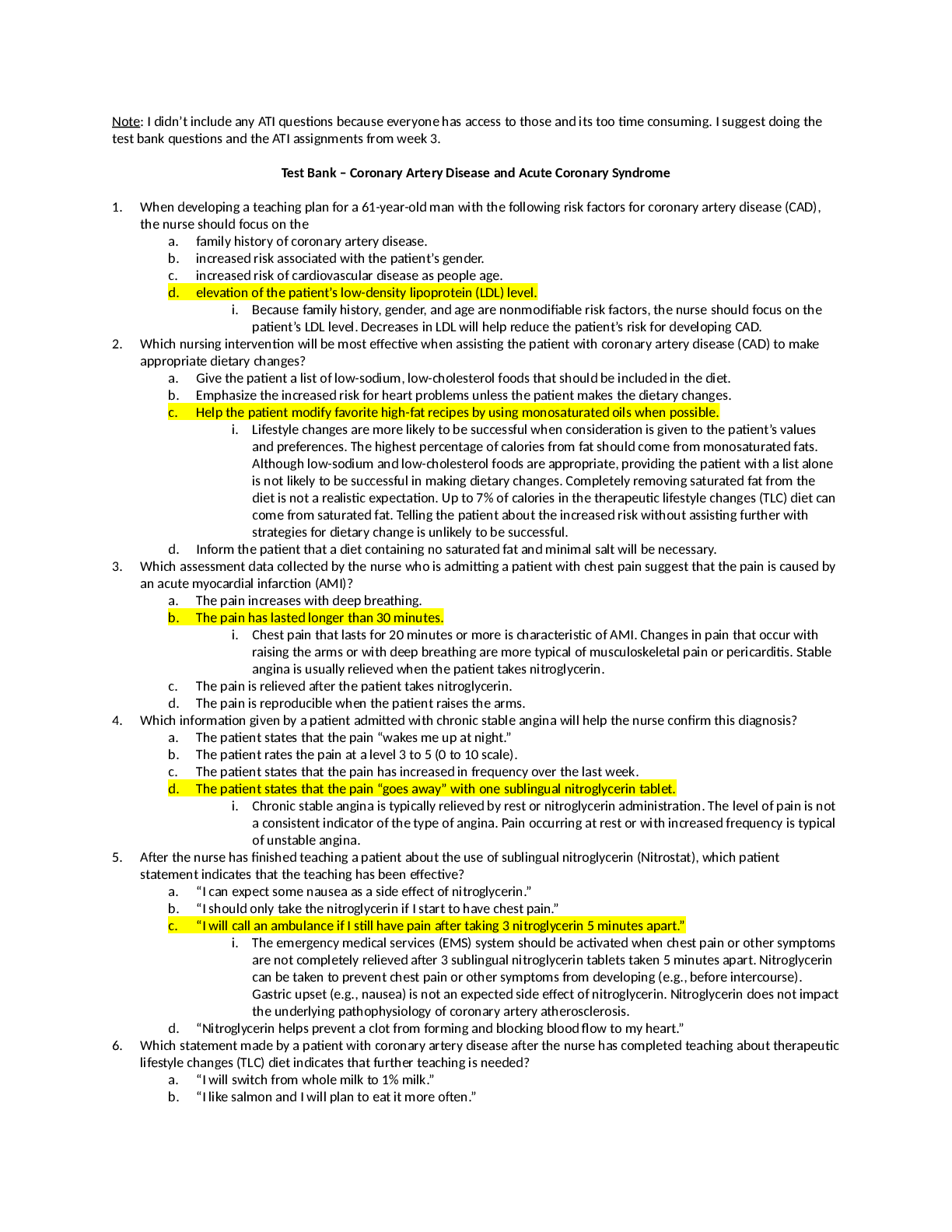
Buy this document to get the full access instantly
Instant Download Access after purchase
Add to cartInstant download
Reviews( 0 )
Document information
Connected school, study & course
About the document
Uploaded On
Dec 24, 2021
Number of pages
29
Written in
Additional information
This document has been written for:
Uploaded
Dec 24, 2021
Downloads
0
Views
73

.png)
.png)
.png)
.png)
.png)
.png)
.png)
.png)
.png)
.png)
.png)

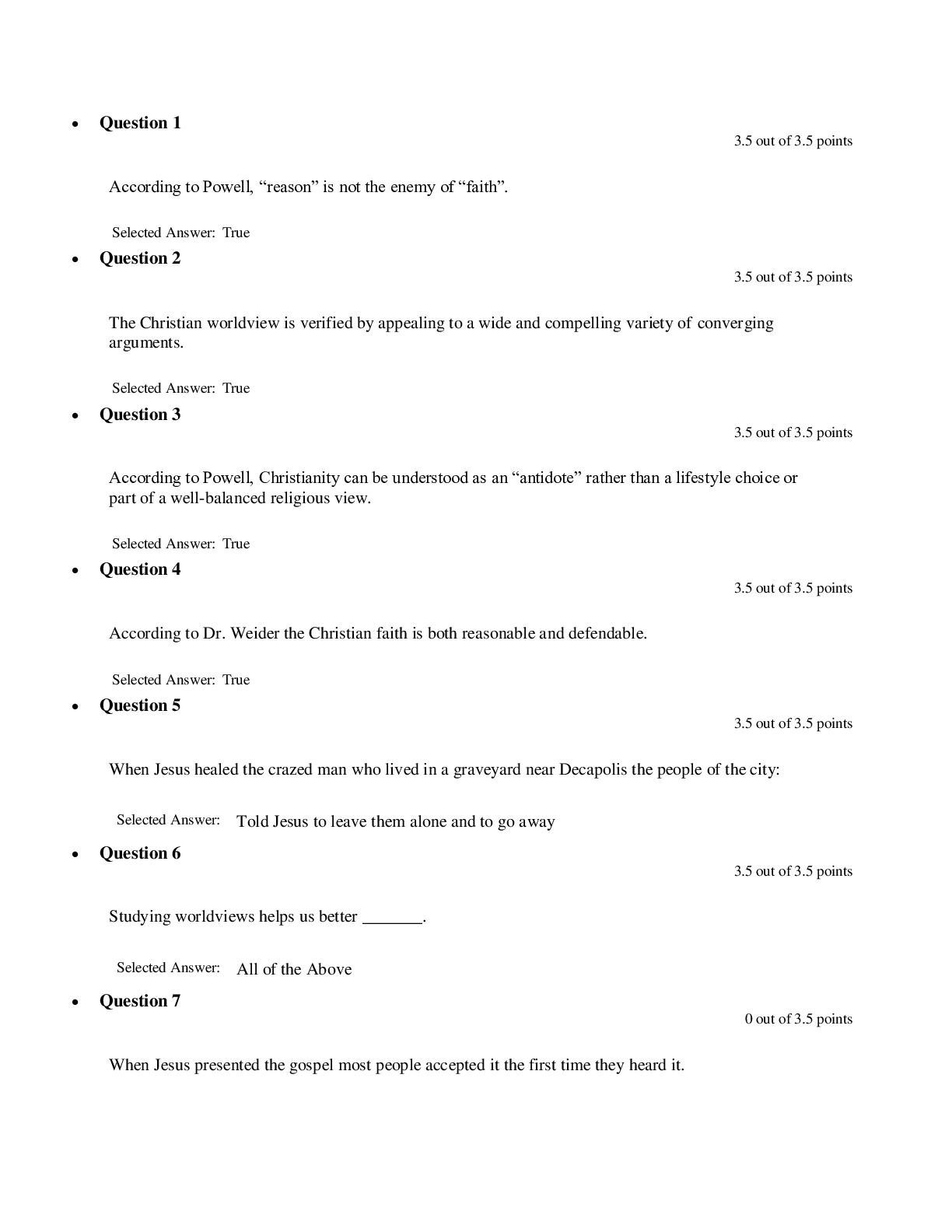

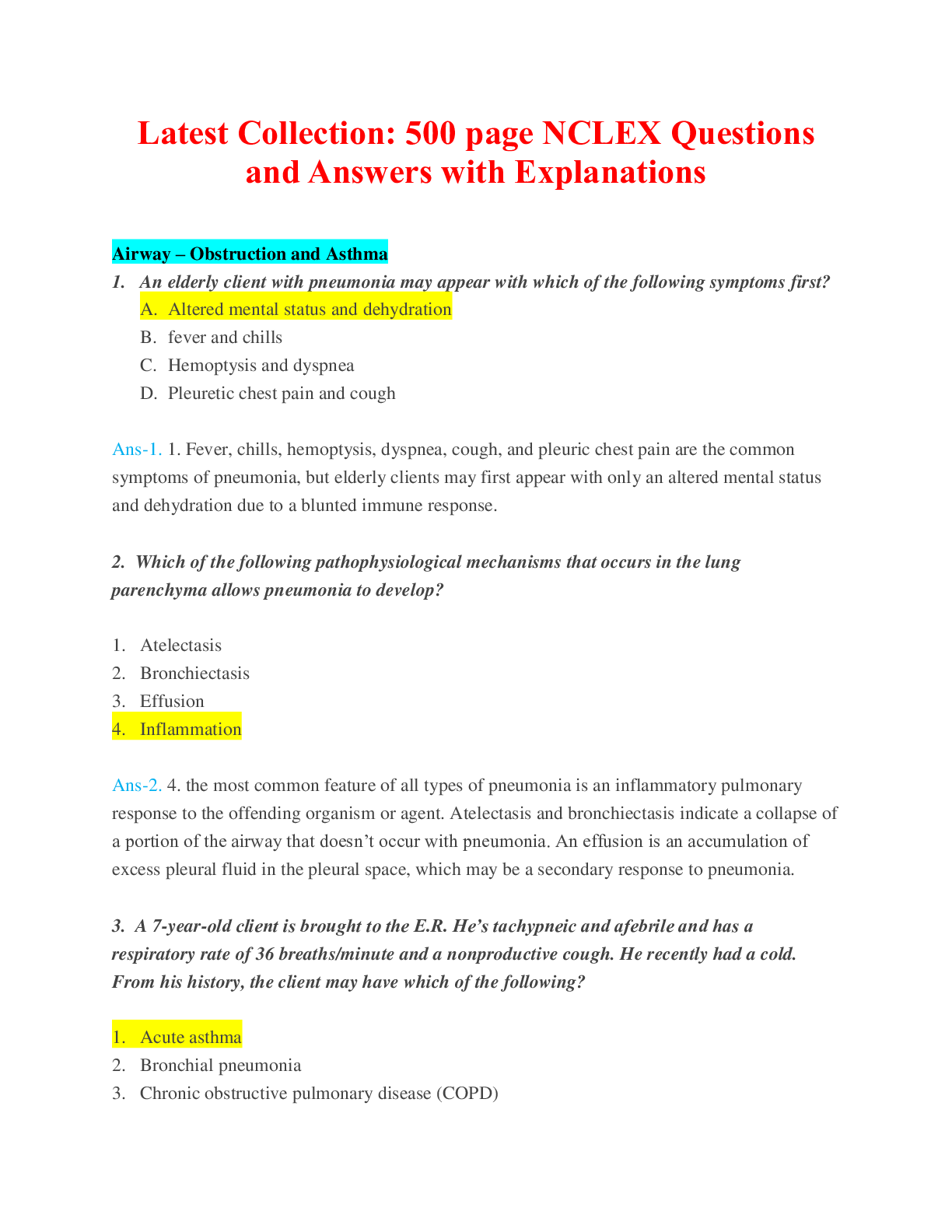
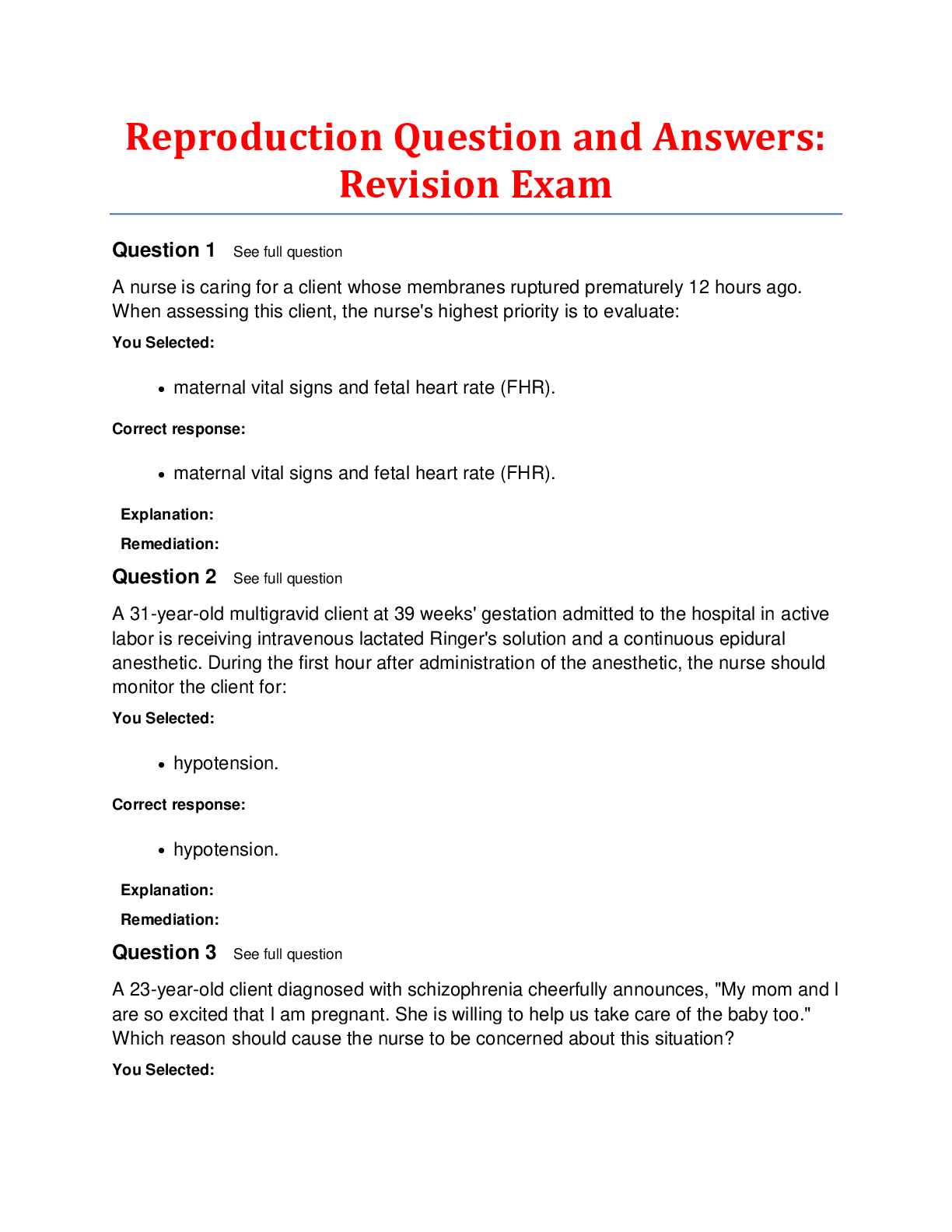
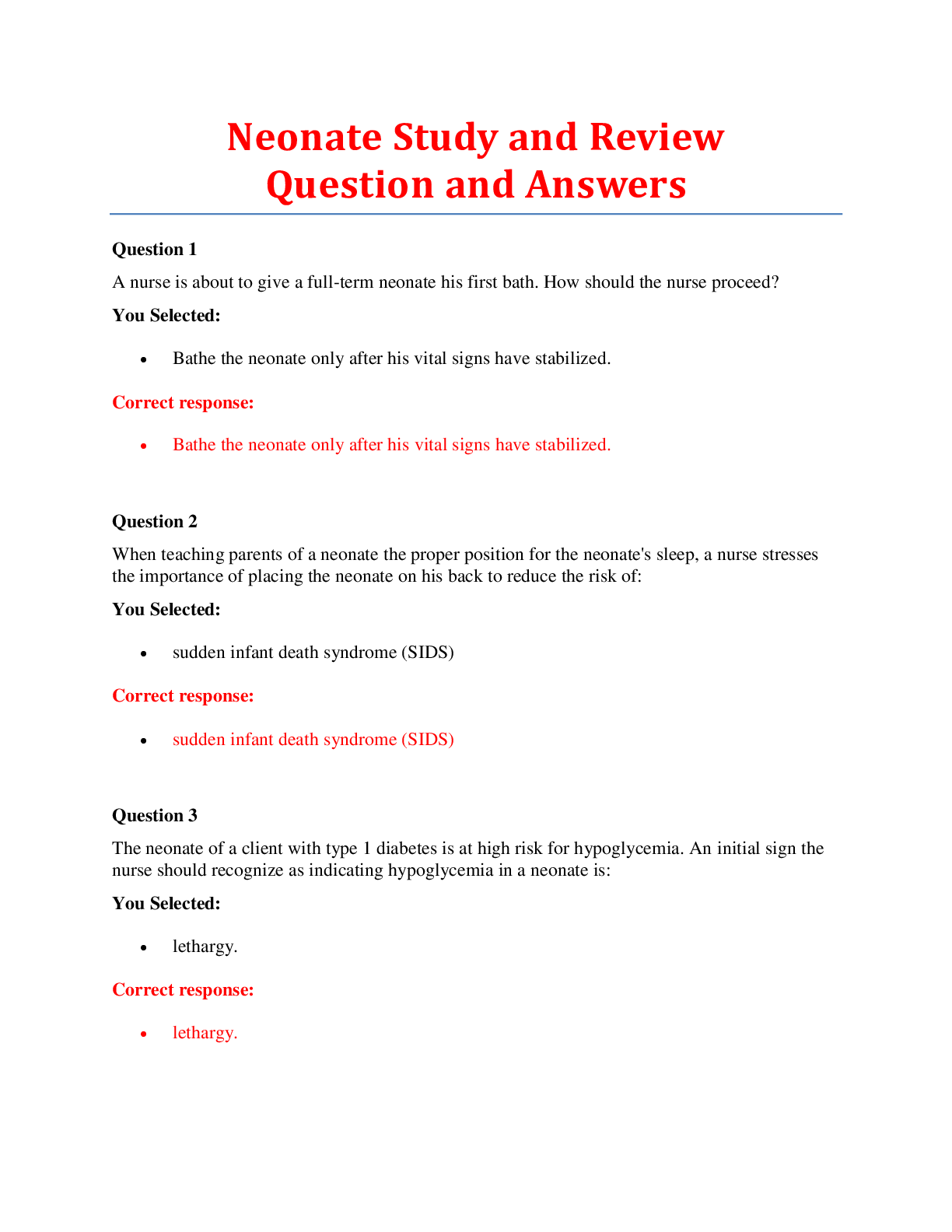
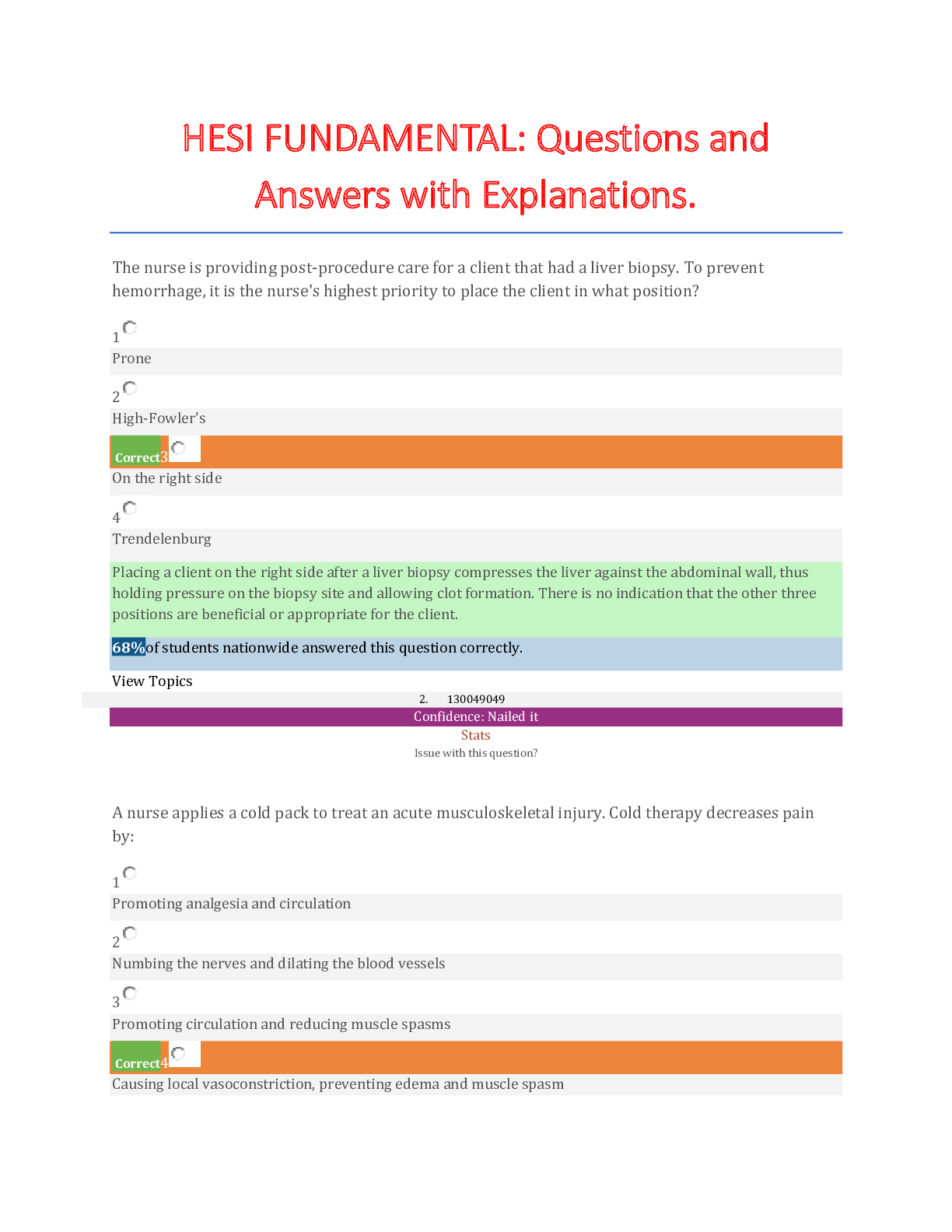
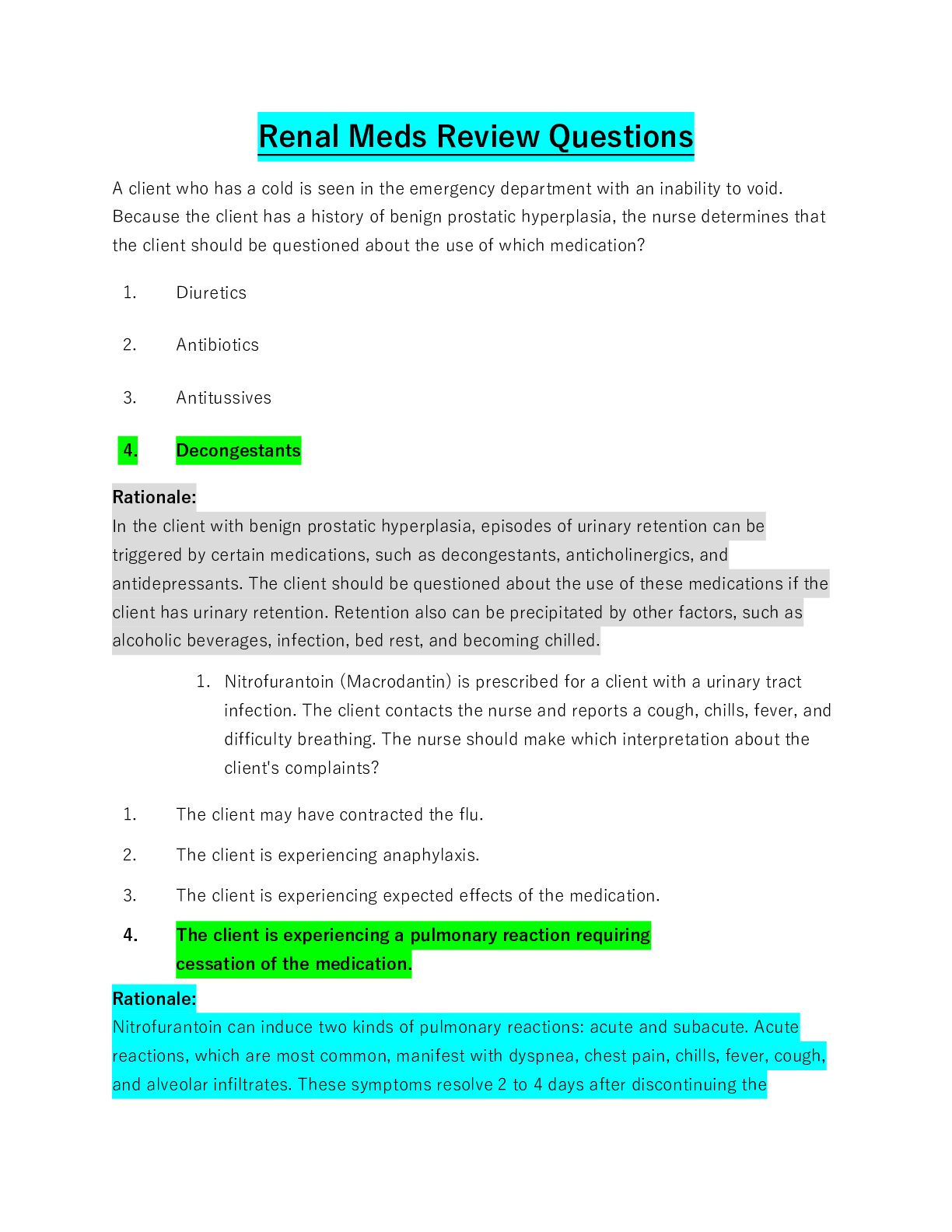

 Latest Rasmussen College NUR NUR 2063 Question and Answers with Explanations.png)

 Questions and Answers with Explanations, 100% Correct, Download to Score A.png)

